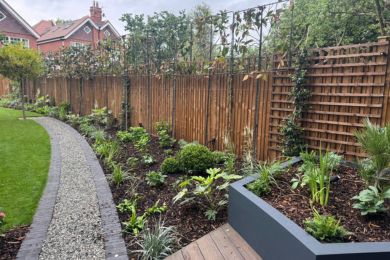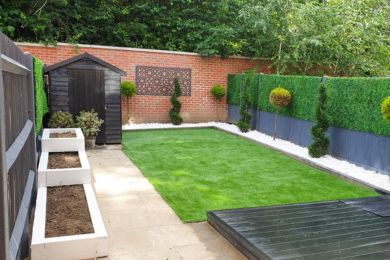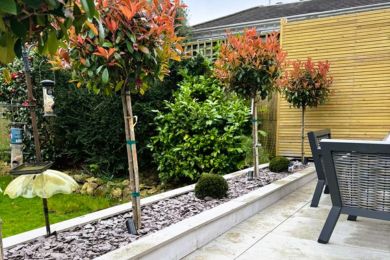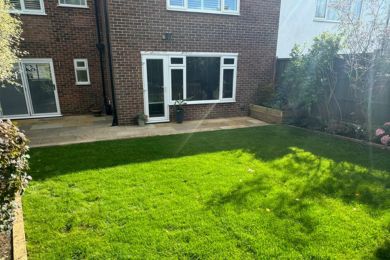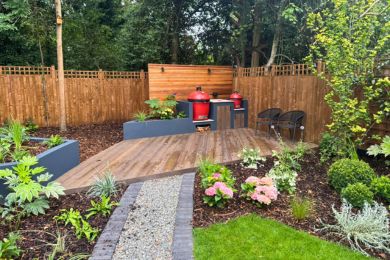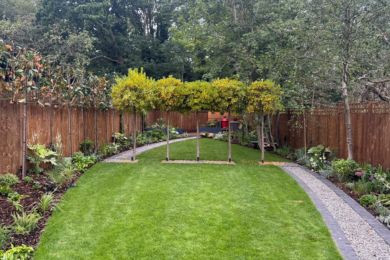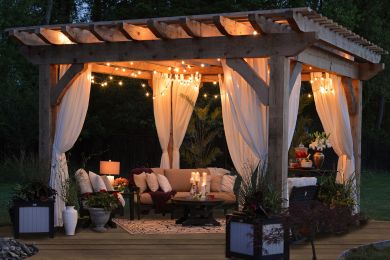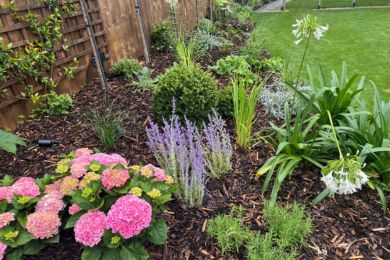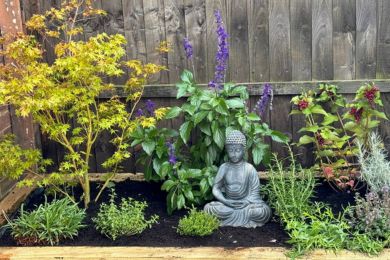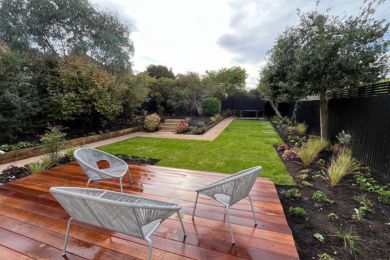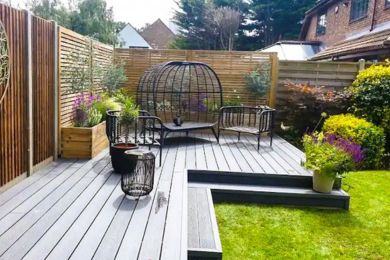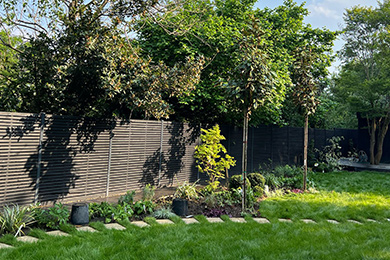A Comprehensive Guide To Garden Design In London
Creating a beautiful garden in London requires more than just planting flowers and hoping for the best. The city’s unique urban environment, variable weather patterns, and diverse architectural styles demand thoughtful planning and expert knowledge to achieve truly spectacular results.
Whether you’re working with a compact courtyard in Shoreditch or a generous back garden in Richmond, understanding how to maximise your outdoor space can transform not just your lifestyle, but also your property’s value.
London homeowners are discovering that a well-designed garden serves as an extension of their living space—a private sanctuary where they can entertain guests, enjoy morning coffee, or simply escape the hustle and bustle of city life.
This comprehensive guide will walk you through everything you need to know about garden design in London, from navigating the city’s climate challenges to exploring popular design styles, understanding costs, and planning your project from start to finish. You’ll discover how to create sustainable, beautiful outdoor spaces that thrive year-round, regardless of your garden’s size or your experience level.
At SilvaTree, we’ve spent years helping London homeowners transform their gardens into stunning, functional spaces that reflect their personalities while working harmoniously with the city’s unique conditions. Our expertise in sustainable design and local climate understanding ensures every project delivers lasting beauty and value.
Contemporary garden design trends in the UK have significantly influenced how London gardens are shaped, reflecting modern housing, cultural preferences, and the unique environment found across the country.
Understanding London’s Climate and Its Impact on Gardens
London’s temperate maritime climate presents both exciting opportunities and specific challenges for garden design. The city enjoys relatively mild winters with temperatures rarely dropping below freezing for extended periods, while summers bring moderate warmth with occasional heatwaves that can test even the hardiest plants.
Rainfall patterns across London are generally consistent throughout the year, with autumn and winter months receiving slightly higher precipitation. This steady moisture supply creates excellent growing conditions for a wide variety of plants, but it also means drainage considerations become crucial in garden planning. Poor drainage can lead to waterlogged soil, root rot, and unsuccessful plantings that disappoint homeowners and waste investment.
Urban pollution adds another layer of complexity to London garden design. Vehicle emissions, industrial activity, and the urban heat island effect can stress plants and create microclimates that differ significantly from surrounding areas. However, this challenge has sparked innovation in plant selection, with many species proving remarkably resilient to city conditions while providing natural air purification benefits.
The city’s compact nature often means gardens receive limited sunlight, particularly during shorter winter days. Buildings, walls, and established trees create shade patterns that change throughout the seasons, requiring careful observation and planning to ensure plants receive adequate light for healthy growth. The location of these elements within the garden directly affects the garden’s sunlight exposure and helps shape unique microclimates, influencing the garden’s overall layout and plant choices.
Despite these challenges, London’s climate offers remarkable versatility for garden enthusiasts. The extended growing season allows for year-round planting opportunities, while the moderate conditions support an impressive range of plant species from around the world. Hardy perennials, robust shrubs, and carefully selected trees can create stunning displays that evolve beautifully through the seasons.
Success in London garden design comes from choosing plants that not only survive but thrive in the garden’s unique urban conditions and microclimate. Native species like English lavender, foxgloves, and hornbeam hedging perform exceptionally well, while carefully selected international varieties can add exotic flair without compromising reliability.
Finding Inspiration for Your London Garden
Establishing your optimal garden design in London begins by utilising appropriate inspirational resources. Given the extensive possibilities for enhancing your outdoor environment, whether optimising a compact garden space in West London or maximising a substantial suburban lawn area, systematically exploring diverse conceptual sources is the right approach to finding a suitable garden design.
By exploring a range of options, you can establish a garden that authentically reflects your aesthetic preferences whilst fulfilling your functional requirements.
Drawing Ideas from the RHS Chelsea Flower Show and Other Sources
The RHS Chelsea Flower Show can be a wonderful source of inspiration and enables garden enthusiasts to identify innovative design concepts efficiently. This internationally recognised event establishes a comprehensive showcase for contemporary trends in garden design, where leading garden designers and landscape architects present advanced layouts, strategic planting schemes, and state-of-the-art features.
When examining the exhibition gardens, one can observe diverse implementations ranging from contemporary-style courtyards featuring architectural plants to comprehensive kitchen gardens incorporating vegetables, herbs, and fruit trees.
The RHS Chelsea Flower Show provides substantial inspiration resources, whether one is developing a rock garden, establishing a formal potager, or implementing a wildlife-friendly retreat. However, inspiration sources extend beyond Chelsea’s parameters. Online platforms, gardening publications, and social media channels consistently deliver professional imagery and practical guidance from experienced gardeners and designers.
Analysing the development of other London gardens, both large and small-scale, can generate innovative concepts for individual spaces. One might identify efficient methodologies for utilising raised beds in restricted areas, or observe how living walls can enhance greenery density and vitality to shaded patio environments.
Nature itself constitutes another significant inspiration resource. It is essential to dedicate time observing how plants, trees, and shrubs develop in local parks, woodlands, or urban street environments. One should analyse sunlight and shade patterns, examine how climbing plants soften boundary structures, or assess how water features attract avian and wildlife populations. These natural elements can be adapted to accommodate individual garden layouts, soil compositions, and lighting conditions.
When developing garden plans, it is crucial to maximise available space utilisation. In compact garden environments, vertical planting systems, living walls, and dwarf fruit trees enable the creation of dense, layered effects without compromising spatial efficiency.
Raised bed configurations prove optimal for productive vegetable gardens or kitchen garden implementations, facilitating planting and maintenance procedures whilst improving drainage capabilities.
For larger garden spaces, one should consider incorporating rock garden features with drought-tolerant plant selections, or establishing distinct zones utilising gravel pathways, stone patio areas, and focal elements such as sculptural trees or garden art installations.
The significance of materials and structural elements requires careful consideration. Stone, gravel, and timber can be utilised to define spatial boundaries, create circulation routes, or construct raised bed systems and retaining wall structures. Fence and trellis installations provide climbing plant support, adding vertical interest and privacy whilst enhancing garden colour and textural diversity. Water features, ranging from basic birdbath installations to sophisticated pond systems, introduce movement elements and attract wildlife populations, thereby enhancing garden tranquillity characteristics.
Selecting appropriate plant varieties is fundamental to achieving desired garden aesthetics. Native plant species demonstrate superior adaptation to London’s climate conditions and support local wildlife ecosystems, whilst incorporating diverse flowers, shrubs, and trees ensures year-round visual interest. Herb and vegetable integration adds both aesthetic and functional value, transforming garden spaces into productive kitchen garden environments.
For contemporary-style implementations, focus on bold foliage selections, clean line compositions, and restricted colour palettes; for traditional approaches, utilise cottage garden varieties and soft, flowing pattern arrangements.
Ultimately, creative leadership should guide development processes. It is essential to experiment with various layout configurations, trial innovative plant combinations, and incorporate personalised elements, whether unique art installations, distinctive water features, or comfortable seating arrangements for observation purposes.
Every garden constitutes a progressive development, evolving with seasonal changes and individual preferences. Through strategic planning and exploratory approaches, one can establish a London garden that achieves both aesthetic and functional objectives, whilst serving as an authentic reflection of lifestyle and personality characteristics.
Popular Garden Design Styles in London
Contemporary Urban Gardens
Modern London homeowners increasingly favour contemporary garden designs that reflect the clean lines and sophisticated aesthetics of urban living. These gardens feature minimalist layouts with carefully curated plant selections, and key elements such as steel planters and concrete features, along with strategic lighting that extends usability into evening hours.
Decking and raised beds define different zones within the space, creating visual interest while maximising functionality. Contemporary urban gardens often incorporate outdoor kitchens, built-in seating, and water features that serve as a focal point and conversation starter during entertaining. Sculptural trees can also act as a striking focal point within the garden.
The plant palette in contemporary designs tends toward architectural specimens with strong forms, ornamental grasses, sculptural succulents, and specimen trees that provide year-round structure. Colour schemes remain restrained, often focusing on foliage textures and forms rather than bright flowering displays.
Traditional English Gardens
The classic English garden style remains deeply popular among London homeowners who appreciate its timeless elegance and romantic character. These gardens celebrate the beauty of herbaceous borders filled with perennials, climbing roses cascading over pergolas, and carefully maintained lawns, where grass is used to create restful green spaces and define the boundaries between different planting areas.
Traditional designs incorporate curved pathways, mixed planting schemes, and cottage garden favourites like delphiniums, hollyhocks, and sweet peas. The informal yet carefully planned aesthetic creates spaces that feel naturally evolved rather than artificially imposed.
Mature trees, established hedging, and traditional materials like natural stone and brick help these gardens blend seamlessly with London’s historic architecture. The style particularly suits Victorian and Edwardian properties, where the garden can complement the home’s original character.
Wildlife-Friendly Gardens
Environmental consciousness has driven significant interest in wildlife-friendly garden design throughout London. These spaces prioritise biodiversity, supporting local wildlife through thoughtful plant choices, habitat creation, and sustainable maintenance practices.
Pollinator-friendly plants take centre stage, with native species like lavender, sedum, and wildflower meadows providing essential resources for bees, butterflies, and other beneficial insects. Bird boxes, hedgehog highways, and small ponds create additional wildlife habitats within urban environments.
The aesthetic appeals to homeowners who want their gardens to contribute positively to London’s urban ecosystem while creating beautiful, ever-changing displays as wildlife visitors bring movement and life to the space. Even the rest of the garden, beyond the main wildlife features, can be designed to support local biodiversity by incorporating diverse plantings and natural areas that blend seamlessly with the surrounding environment.
Eco-Friendly and Sustainable Gardens
Sustainability has become a cornerstone of modern London garden design, with homeowners seeking solutions that reduce environmental impact while creating beautiful outdoor spaces. These gardens incorporate rainwater harvesting systems, permeable paving materials, and composting areas that manage organic waste effectively.
Native plant selections reduce water requirements, support local ecosystems, and make gardens easier to maintain, requiring less effort and resources for ongoing care. Solar-powered lighting and water features minimise energy consumption. Green roofs and living walls maximise growing space in compact urban environments while providing insulation benefits.
Sustainable gardens often feature productive elements like vegetable plots, herb spirals, and fruit trees that provide fresh food while reducing household environmental footprints. SilvaTree specialises in creating these eco-conscious designs that deliver both environmental benefits and stunning aesthetics.
Small-Space and Courtyard Gardens
London’s property prices mean many homeowners work with compact outdoor spaces that require creative design solutions to maximise impact and functionality. Small gardens and courtyards can become jewel-like spaces that feel surprisingly spacious through clever planning and design techniques. Certain layouts, such as staggered beds or diagonal pathways, can create the impression of more space and improve accessibility.
Vertical planting systems, wall-mounted planters, and tiered container arrangements create abundant growing space without overwhelming a limited ground area. Multi-level designs and strategic use of mirrors can visually expand tight spaces, while carefully chosen plants provide privacy screening and visual interest.
Container gardening allows for seasonal flexibility and enables homeowners to experiment with different plant combinations throughout the year. Trying out container gardening or vertical planting can also make gardening more fun in small spaces. SilvaTree’s expertise in small-space design helps clients create remarkable transformations that maximise every square metre of available space.
Planning Your Garden Design
Successful garden design begins with a thorough assessment of your outdoor space and a clear definition of your goals and priorities.
Understanding your landscape’s unique characteristics, size, orientation, soil conditions, drainage patterns, and existing features provides the foundation for making informed design decisions. Consider introducing the idea of using creative concepts or innovative approaches to make your garden truly unique.
Start by observing how sunlight moves across your space throughout different times of day and seasons. Note which areas receive full sun, partial shade, or remain predominantly shaded, as this information will guide plant selection and feature placement. Take photos from various angles to document existing conditions and help visualise potential improvements.
Soil testing reveals crucial information about pH levels, drainage characteristics, and nutrient content. London’s varied geology means soil conditions can differ significantly even between neighbouring properties. Understanding your soil helps determine which plants will thrive naturally and whether amendments or drainage improvements might be necessary.
Consider your lifestyle and how you want to use your garden space. Families with children might prioritise safe play areas and durable materials, while frequent entertainers may focus on outdoor dining spaces and atmospheric lighting. Those seeking relaxation might emphasise secluded seating areas and tranquil water features.
Creating functional zones helps organise your space effectively, even in compact gardens. Carefully planning your garden layout allows you to define separate areas for dining, lounging, planting, and storage through level changes, different materials, or strategic plant placement. This approach maximises functionality while maintaining visual coherence.
Professional garden designers bring invaluable expertise to the planning process, particularly for London’s unique challenges. At SilvaTree, our personalised design consultations help clients navigate complex decisions while ensuring their vision aligns with practical considerations like drainage, planning permissions, and long-term maintenance requirements.
Take time to explore different garden layout options and features to find the best fit for your needs and preferences.
Costs of Garden Design in London
Understanding the investment required for garden design projects helps homeowners plan effectively and make informed decisions about scope, materials, and professional services. London garden design costs vary significantly based on project size, complexity, material choices, and the level of professional involvement required.
For example, designing a large garden often involves additional considerations and higher costs due to the need for zoning different areas, creating pathways, and incorporating multiple features.
Basic Garden Refresh Projects
Entry-level garden improvements typically range from £2,000 to £8,000 and focus on immediate visual impact through plant updates, lawn improvement, and simple features. These projects might include new flower borders, lawn restoration, basic pathway creation, and small decorative elements like planters, garden lighting, or decorative stones.
Basic refreshes work well for homeowners who want to improve their garden’s appearance without major structural changes. New plant selections can dramatically transform a space’s character, while lawn care and simple hardscaping create immediate improvements that enhance daily enjoyment.
Mid-Range Garden Transformations
Comprehensive garden makeovers typically cost between £8,000 and £25,000, depending on space size and feature complexity. These projects often include bespoke planting plans designed for year-round interest, new paving or decking areas, garden structures like pergolas or summerhouses, new fence installation as a boundary or privacy feature, and integrated irrigation systems.
Mid-range projects allow for significant design flexibility while incorporating durable materials and professional installation. Custom plant selections, drainage improvements, and attractive hardscaping create gardens that provide lasting satisfaction and increased property value.
Premium Garden Design Projects
High-end London garden designs can range from £25,000 to £100,000 or more, incorporating luxury features like outdoor kitchens, sophisticated lighting systems, water features, rock gardens, and extensive structural work. These projects often involve significant earthmoving, custom-built features, and premium materials throughout.
Premium projects deliver show-stopping results that transform properties and lifestyles. Outdoor entertaining spaces rival indoor kitchens, while sophisticated planting schemes and architectural features create year-round beauty that enhances property values significantly.
Factors Affecting Garden Design Costs
Several key factors influence final project costs beyond basic size considerations. Site access affects material delivery and equipment use, with restricted access potentially increasing labour requirements. Existing conditions like poor drainage, contaminated soil, or established trees requiring special care can add complexity and cost.
Material choices significantly impact budgets, with natural stone, hardwood decking, and custom metalwork commanding premium prices compared to concrete alternatives. However, quality materials often provide better long-term value through durability and timeless aesthetics that age gracefully.
Professional design services typically represent 10-15% of total project costs but deliver significant value through expertise, project coordination, and design solutions that maximise both beauty and functionality. SilvaTree’s transparent pricing approach helps clients understand exactly what their investment includes, with detailed quotes that eliminate surprises and enable confident decision-making.
Sustainability and Eco-Friendly Design
Environmental responsibility has become central to contemporary London garden design, driven by both ecological awareness and practical benefits like reduced maintenance costs and improved local climate resilience. Sustainable garden practices support the city’s broader environmental goals while creating beautiful, thriving outdoor spaces that enhance and contribute to healthier urban landscapes.
Water management represents a crucial sustainability consideration in urban gardens. Rainwater harvesting systems collect and store precipitation for irrigation use, reducing dependence on mains water while managing surface runoff that can overwhelm London’s drainage infrastructure during heavy rainfall events.
Permeable paving materials allow rainwater to infiltrate naturally rather than contributing to surface flooding, while planted swales and rain gardens can manage drainage elegantly within the overall design aesthetic. These features often become attractive focal points while serving important environmental functions.
Native plant selections provide multiple sustainability benefits, requiring less water, fertiliser, and pest control while supporting local wildlife populations. London’s native flora includes beautiful options like English bluebells, wild garlic, and native meadow grasses that create stunning displays while supporting biodiversity.
Composting systems integrated into garden design help manage household organic waste while producing valuable soil amendments. Modern composting solutions can be attractive and odour-free while reducing landfill waste and creating a nutrient-rich growing medium for garden plants.
Solar-powered garden features like lighting and water circulation pumps reduce energy consumption while providing practical functionality. LED lighting systems can create a dramatic evening ambience while using minimal electricity, extending garden usability into darker months.
Green roofs and living walls maximise growing space in compact urban environments while providing insulation, air filtration, and wildlife habitat. These innovative features can become stunning architectural elements while delivering measurable environmental benefits.
SilvaTree’s commitment to sustainable landscaping practices ensures every project contributes positively to London’s urban environment while creating lasting beauty that clients can feel proud of supporting. Our sustainable approach often reduces long-term maintenance requirements while creating gardens that become more beautiful over time.
Working with a Professional Garden Designer
Professional garden design services bring essential expertise, creative vision, and project management skills that can transform challenging spaces into remarkable outdoor environments. London’s unique conditions—from planning restrictions to soil variations—require local knowledge that experienced designers possess.
The design process typically begins with a detailed site consultation, where professionals assess existing conditions, understand client goals, and identify opportunities and constraints. This comprehensive evaluation forms the foundation for creating realistic, achievable designs that deliver lasting satisfaction.
Professional designers provide creative solutions that clients might not envision independently. Years of experience with different sites, materials, and plants enable designers to suggest innovative approaches that maximise space, solve practical problems, and create unique features that reflect individual personalities and lifestyles.
Project coordination represents another significant benefit of professional services. Designers manage relationships with contractors, suppliers, and local authorities, ensuring work proceeds smoothly and meets all relevant standards and regulations. This coordination reduces stress for homeowners while ensuring quality results.
Plant knowledge and sourcing expertise ensure garden plantings thrive in London conditions. Professional designers understand which varieties perform best in different microclimates, soil types, and maintenance regimes. They also have access to specialist nurseries and high-quality specimens that may not be available through retail channels.
Technical expertise helps navigate London’s planning requirements, building regulations, and safety considerations. From drainage solutions to structural work, professional designers ensure projects meet all necessary standards while achieving desired aesthetic goals.
SilvaTree’s comprehensive service approach guides clients through every project phase, from initial consultation through design development, construction supervision, and establishment care. Our local expertise and established relationships with trusted contractors ensure smooth project delivery and exceptional results that exceed expectations.
The investment in professional design services typically provides excellent value through avoiding mistakes, creative solutions, and access to trade pricing on materials and plants. Well-designed gardens enhance property values significantly while providing years of enjoyment and pride of ownership.
Transform Your London Garden with Expert Design
Creating a beautiful, functional garden in London requires understanding the city’s unique conditions, exploring design possibilities that suit your lifestyle, and making informed decisions about investment levels and professional services. From compact courtyards to generous suburban plots, every London garden has potential for transformation into a space that enhances daily life and property value.
Climate considerations, design style preferences, sustainability goals, and budget parameters all influence the final outcome, but thoughtful planning and expert guidance can navigate these factors successfully. Whether you’re drawn to contemporary minimalism, traditional English charm, or eco-friendly innovation, professional design services can bring your vision to life while addressing practical considerations.
The investment in quality garden design pays dividends through increased property values, enhanced lifestyle benefits, and the deep satisfaction of creating beautiful outdoor spaces that evolve and improve over time. London’s growing season and moderate climate provide exceptional opportunities for year-round garden enjoyment, making professional design investment particularly worthwhile.
Contact Us Today
Ready to transform your outdoor space into the garden of your dreams? Contact SilvaTree today for a personalised garden design consultation that explores your space’s potential and creates a tailored plan for achieving your vision.
Whether you have a small courtyard or a large family garden, our expertise in London garden design can bring your ideas to life with sustainable solutions that deliver lasting beauty and value.
Frequently Asked Questions
What plants grow best in London gardens?
London’s temperate climate supports a wide variety of plants, with native species often performing exceptionally well. Hardy perennials like lavender, sedum, and ornamental grasses thrive in urban conditions while requiring minimal maintenance. Traditional favourites such as roses, clematis, and herbaceous border plants create beautiful displays when properly sited.
For year-round structure, consider English yew, hornbeam hedging, or architectural specimens like Japanese maples that provide seasonal interest while tolerating London’s variable conditions.
How much does it cost to redesign a small garden in London?
Small London garden redesigns typically range from £5,000 to £20,000, depending on the scope of work and material choices. Basic refreshes focusing on new planting and simple features start around £5,000, while comprehensive transformations including new paving, structures, and sophisticated planting schemes can reach £15,000-20,000.
Factors affecting cost include site access, existing conditions, drainage requirements, and the level of custom features desired. Professional design services help maximise value by ensuring efficient use of space and appropriate material selection.
Do I need planning permission for garden design changes?
Most garden design projects fall under permitted development rights and don’t require planning permission. However, certain changes may need approval, including structures over specific heights, extensions to listed buildings, or work affecting neighbours’ properties.
Conservation areas and listed building designations can impose additional restrictions. It’s essential to check with your local planning authority before beginning work, particularly for substantial structures, boundary changes, or drainage modifications. Professional designers can navigate these requirements and advise on necessary permissions.

